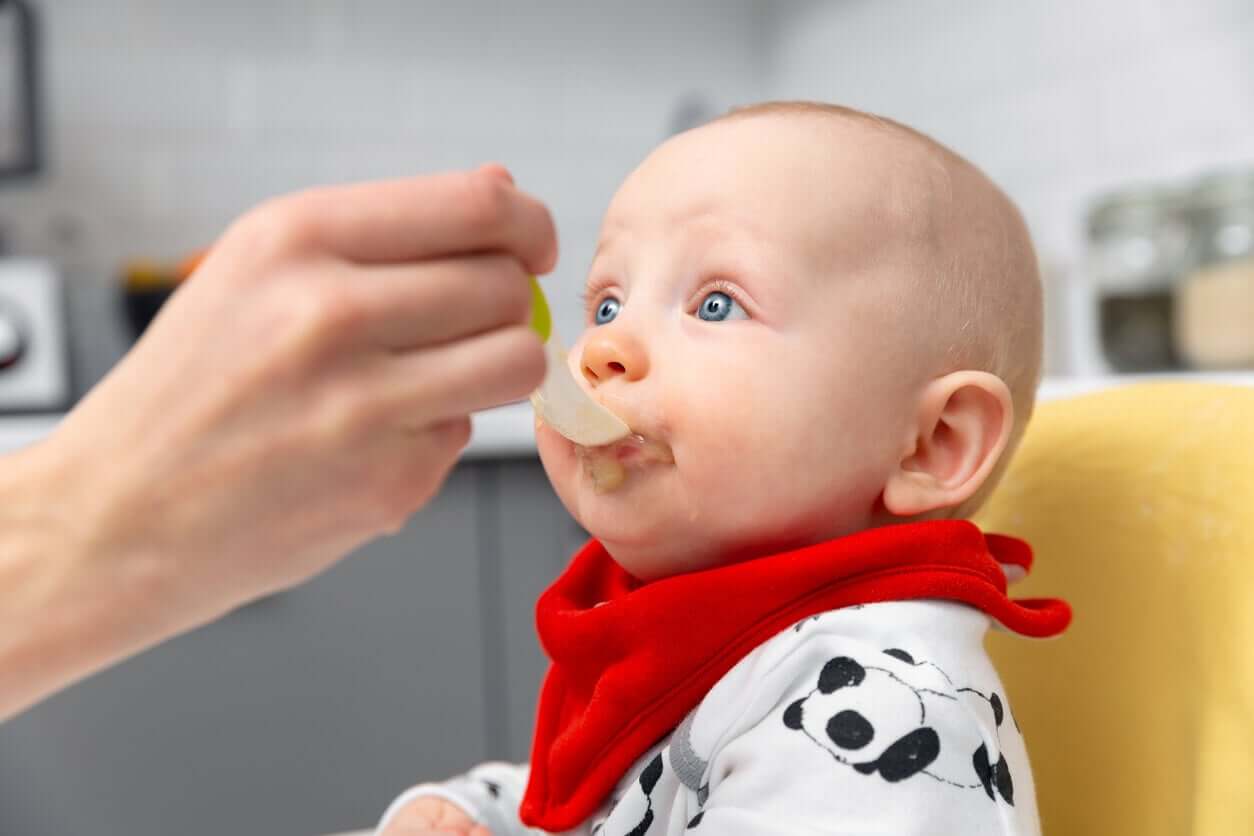Vomiting in Babies: When to Worry

Parents are often upset when their children vomit, and although it’s a very common occurrence in babies, it’s important to know why it happens. Likewise, parents need to be able to recognize those alarm signals that require frequent consultation with a pediatrician. Find out about vomiting in babies in the following article.
What is vomiting in babies?
Vomiting is a complex reflex act, by means of which the stomach releases its contents into the esophagus and then out through the mouth.
Unlike what happens in regurgitations or gastroesophageal reflux, vomiting involves a coordinated effort between the following organs:
- Digestive tract: Stomach, esophagus, mouth.
- Muscles of the thorax and abdomen: Diaphragm, abdominal wall, intercostals, among others.
- Sphincters: These are the gates that separate the digestive cavities and that must be opened simultaneously.
This reaction in the body occurs for various reasons, but in all cases, the nervous center that coordinates this mechanism is activated, with the aim of eliminating stomach contents.

Causes of vomiting in babies
Vomiting is a very common symptom in childhood and its causes aren’t always digestive. In some diseases, they’re the predominant symptom, while in others, they’re a secondary manifestation.
Here are the most common causes of vomiting in babies.
Infections
This is the most common reason for vomiting in childhood and can be viral, bacterial, parasitic, or fungal in origin.
Some infections occur directly in the digestive tract, such as gastroenteritis or hepatitis, and vomiting is a predominant symptom.
Other infections, such as otitis or urinary infections, can manifest themselves through this symptom. The smaller the baby, the more likely vomiting is part of the clinical picture. On the contrary, in the case of meningitis, this rule is reversed, and vomiting usually appears as a manifestation in older children.
There’s another type of more severe and generalized infection (sepsis), which are characterized by more intense and variable symptoms, which occur in children in a regular general condition. Within the spectrum of possible manifestations is vomiting.
Poisonings
After infections, poisonings are the most common cause, and within these, those caused by food. These occur as a result of inadequate hygiene during food handling, preparation, or preservation. Although they’re more frequent in the summer, they can occur throughout the year.
An example of these are dairy products that have managed to warm up at some point. Although we often warn of changes in flavor, these don’t always take place.
In addition to food, poisoning from certain medications (such as aspirin) or environmental toxins (such as lead or mercury) can manifest themselves through vomiting.
Allergies
With a young baby vomiting, it’s important to consider a possible allergy to cow’s milk protein. Although there’s no single form of presentation for this condition, vomiting is usually a frequent symptom and it’s important that the doctor consider it among the differential diagnoses. Especially when the baby vomits frequently.
Digestive obstructions
The digestive system is made up of several tubular structures, which form a continuation from the mouth to the anus.
When the passage of food is obstructed at any level, traffic in the area prior to the obstruction becomes congested, such as that which occurs in a vehicular jam. This causes the food to return back to the mouth and be eliminated through vomiting.
Some conditions that produce this condition are the following:
- Meconium ileus
- Pyloric stenosis
- Foreign bodies or bezoars
- Hernias, invaginations, or intestinal volvulus
Other causes
Less often, vomiting in babies may be due to other causes. Among them, metabolic diseases (such as congenital adrenal hyperplasia), neurological diseases (such as cerebral edema), kidney, heart, or liver diseases.
What are the risks of vomiting in babies?
In the presence of vomiting in a small baby, we must think about what happens to their body and what’s causing the child to vomit.
At this point, it’s important to differentiate vomiting from regurgitation (involuntary and effortless elimination) or reflux (more progressive and chronic).
In itself, vomiting involves a loss of body fluids. If this symptom persists throughout the day and is accompanied by the inability to replace them through the mouth (oral intolerance), the child ends up dehydrated.
When dehydration goes from mild to severe depends, to a large extent, on the age and size of the child. So, the younger the age, the greater the risk of dehydration in the baby.
How can I help my baby when they’re vomiting?
The most important thing to control in a baby with vomiting is the state of hydration and for this, you need to take into account the following tips:
1. Take a feeding break after vomiting
It’s important to stop feeding the baby after vomiting so that their body can recover. In this sense, it’s important to provide them with certain comfort measures, such as sanitizing them, keeping them upright, and reassuring them.
For a while, it’s best not to offer liquids so the child can overcome their nausea and discomfort.
2. When the time is right, offer fractionated liquids
Once the baby has recovered and accepts it, offer liquids in small amounts.
Remember that their stomach’s still sensitive and can’t tolerate large volumes at once. For this reason, it’s best they receive the usual volume but spread over a greater number of smaller intakes.
- If the baby is breastfeeding, offer the breast as usual and observe their signals. Babies who breastfeed tend to self-regulate and divide the intake themselves.
- If the baby receives formula milk, you’ll need to offer smaller volumes, several times. It can be with a bottle, with a spoon, or with a syringe.
- If the child is older than 6 months, fresh, fractional clear liquids can be offered: Water or oral rehydration serums.
The use of sugary drinks or fruit juices or sports drinks for this purpose isn’t recommended.
3. Check diapers
In response to dehydration, babies tend to urinate less. When this occurs, it’s important to reinforce hydration measures, as the loss has exceeded the intake.
In turn, when dehydration resolves, it’s common to make sure that the baby returns to wetting their diapers at the usual rate.
4. Restart the usual diet
If the baby already eats, as they improve, they can be offered the usual foods in their diet. In general, cereals, chicken, turkey, fruits, and vegetables are well tolerated.

When should I take the baby to the emergency room?
According to the recommendations of the Spanish Society of Pediatric Emergencies, you should seek emergency medical treatment when the baby with vomiting meets some of the following criteria:
- Is younger than 3 months and has already vomited two or more feedings.
- Their vomiting is frequent and profuse.
- Has an inability to retain fluids in their stomach for more than 15 minutes.
- They have vomit that’s green, bloody, or looks like coffee grounds.
- They’re feeling down, they’re very thirsty, their eyes are more sunken, they cry without tears, or they urinate less than usual.
Parents are often upset when their children vomit, and although it’s a very common occurrence in babies, it’s important to know why it happens. Likewise, parents need to be able to recognize those alarm signals that require frequent consultation with a pediatrician. Find out about vomiting in babies in the following article.
What is vomiting in babies?
Vomiting is a complex reflex act, by means of which the stomach releases its contents into the esophagus and then out through the mouth.
Unlike what happens in regurgitations or gastroesophageal reflux, vomiting involves a coordinated effort between the following organs:
- Digestive tract: Stomach, esophagus, mouth.
- Muscles of the thorax and abdomen: Diaphragm, abdominal wall, intercostals, among others.
- Sphincters: These are the gates that separate the digestive cavities and that must be opened simultaneously.
This reaction in the body occurs for various reasons, but in all cases, the nervous center that coordinates this mechanism is activated, with the aim of eliminating stomach contents.

Causes of vomiting in babies
Vomiting is a very common symptom in childhood and its causes aren’t always digestive. In some diseases, they’re the predominant symptom, while in others, they’re a secondary manifestation.
Here are the most common causes of vomiting in babies.
Infections
This is the most common reason for vomiting in childhood and can be viral, bacterial, parasitic, or fungal in origin.
Some infections occur directly in the digestive tract, such as gastroenteritis or hepatitis, and vomiting is a predominant symptom.
Other infections, such as otitis or urinary infections, can manifest themselves through this symptom. The smaller the baby, the more likely vomiting is part of the clinical picture. On the contrary, in the case of meningitis, this rule is reversed, and vomiting usually appears as a manifestation in older children.
There’s another type of more severe and generalized infection (sepsis), which are characterized by more intense and variable symptoms, which occur in children in a regular general condition. Within the spectrum of possible manifestations is vomiting.
Poisonings
After infections, poisonings are the most common cause, and within these, those caused by food. These occur as a result of inadequate hygiene during food handling, preparation, or preservation. Although they’re more frequent in the summer, they can occur throughout the year.
An example of these are dairy products that have managed to warm up at some point. Although we often warn of changes in flavor, these don’t always take place.
In addition to food, poisoning from certain medications (such as aspirin) or environmental toxins (such as lead or mercury) can manifest themselves through vomiting.
Allergies
With a young baby vomiting, it’s important to consider a possible allergy to cow’s milk protein. Although there’s no single form of presentation for this condition, vomiting is usually a frequent symptom and it’s important that the doctor consider it among the differential diagnoses. Especially when the baby vomits frequently.
Digestive obstructions
The digestive system is made up of several tubular structures, which form a continuation from the mouth to the anus.
When the passage of food is obstructed at any level, traffic in the area prior to the obstruction becomes congested, such as that which occurs in a vehicular jam. This causes the food to return back to the mouth and be eliminated through vomiting.
Some conditions that produce this condition are the following:
- Meconium ileus
- Pyloric stenosis
- Foreign bodies or bezoars
- Hernias, invaginations, or intestinal volvulus
Other causes
Less often, vomiting in babies may be due to other causes. Among them, metabolic diseases (such as congenital adrenal hyperplasia), neurological diseases (such as cerebral edema), kidney, heart, or liver diseases.
What are the risks of vomiting in babies?
In the presence of vomiting in a small baby, we must think about what happens to their body and what’s causing the child to vomit.
At this point, it’s important to differentiate vomiting from regurgitation (involuntary and effortless elimination) or reflux (more progressive and chronic).
In itself, vomiting involves a loss of body fluids. If this symptom persists throughout the day and is accompanied by the inability to replace them through the mouth (oral intolerance), the child ends up dehydrated.
When dehydration goes from mild to severe depends, to a large extent, on the age and size of the child. So, the younger the age, the greater the risk of dehydration in the baby.
How can I help my baby when they’re vomiting?
The most important thing to control in a baby with vomiting is the state of hydration and for this, you need to take into account the following tips:
1. Take a feeding break after vomiting
It’s important to stop feeding the baby after vomiting so that their body can recover. In this sense, it’s important to provide them with certain comfort measures, such as sanitizing them, keeping them upright, and reassuring them.
For a while, it’s best not to offer liquids so the child can overcome their nausea and discomfort.
2. When the time is right, offer fractionated liquids
Once the baby has recovered and accepts it, offer liquids in small amounts.
Remember that their stomach’s still sensitive and can’t tolerate large volumes at once. For this reason, it’s best they receive the usual volume but spread over a greater number of smaller intakes.
- If the baby is breastfeeding, offer the breast as usual and observe their signals. Babies who breastfeed tend to self-regulate and divide the intake themselves.
- If the baby receives formula milk, you’ll need to offer smaller volumes, several times. It can be with a bottle, with a spoon, or with a syringe.
- If the child is older than 6 months, fresh, fractional clear liquids can be offered: Water or oral rehydration serums.
The use of sugary drinks or fruit juices or sports drinks for this purpose isn’t recommended.
3. Check diapers
In response to dehydration, babies tend to urinate less. When this occurs, it’s important to reinforce hydration measures, as the loss has exceeded the intake.
In turn, when dehydration resolves, it’s common to make sure that the baby returns to wetting their diapers at the usual rate.
4. Restart the usual diet
If the baby already eats, as they improve, they can be offered the usual foods in their diet. In general, cereals, chicken, turkey, fruits, and vegetables are well tolerated.

When should I take the baby to the emergency room?
According to the recommendations of the Spanish Society of Pediatric Emergencies, you should seek emergency medical treatment when the baby with vomiting meets some of the following criteria:
- Is younger than 3 months and has already vomited two or more feedings.
- Their vomiting is frequent and profuse.
- Has an inability to retain fluids in their stomach for more than 15 minutes.
- They have vomit that’s green, bloody, or looks like coffee grounds.
- They’re feeling down, they’re very thirsty, their eyes are more sunken, they cry without tears, or they urinate less than usual.
All cited sources were thoroughly reviewed by our team to ensure their quality, reliability, currency, and validity. The bibliography of this article was considered reliable and of academic or scientific accuracy.
- Pellicer Martinez A, Moreno Sanz-Gadea B. Vómitos en el neonato y lactante. Pediatr Integral 2019; XXIII (3): 138 – 146.
- Ortega Paez E. Temas de Salud: Vómitos. En Familia. Asociación Española de Pediatría. Publicado en 2012, revisado en 2019. Disponible en: https://enfamilia.aeped.es/temas-salud/vomitos. Downloaded May 2021.
- Sreedharan R, Liacouras C. Major Symptoms and Signs of Digestive Tract Disorders. Chapter 306. En: Kliegman R et al. Nelson Textbook of Pediatrics. 20th Edition. Elsevier. Philadelphia. 2016.
- Diaz JJ, et al. Manejo del Niño Vomitador. Capitulo 20. En: Acuña Quiroz MD, et al. Protocolos diagnóstico-terapéuticos de Gastroenterología, Hepatología y Nutrición Pediátrica SEGHNP-AEP. Editorial Ergón. Madrid. Año 2010.
- Sociedad Española de Urgencias de Pediatría. Hojas Informativas para padres: Vómitos. Disponible en: https://seup.org/pdf_public/pub/hojas_padres/vomitos.pdf. Downloaded May 2021.
This text is provided for informational purposes only and does not replace consultation with a professional. If in doubt, consult your specialist.








